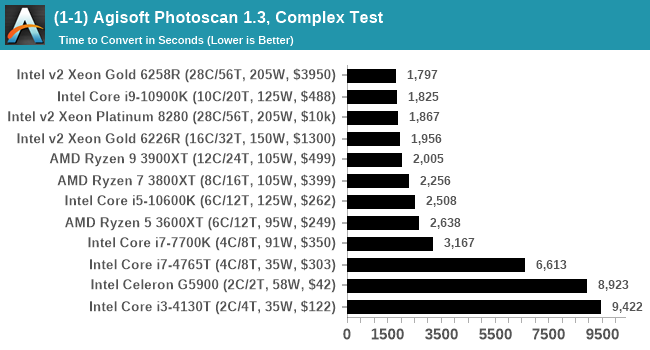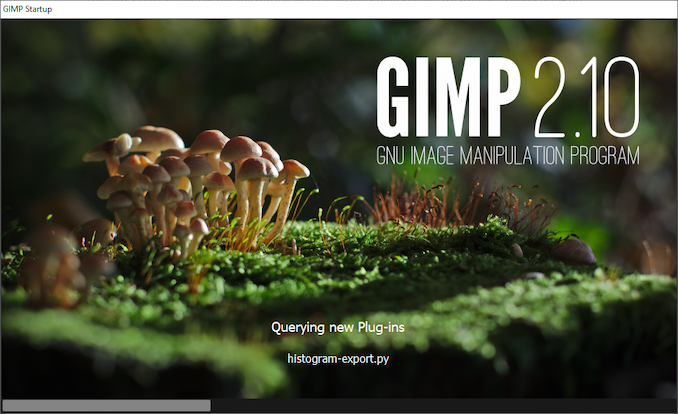Launching the #CPUOverload Project: Testing Every x86 Desktop Processor since 2010
by Dr. Ian Cutress on July 20, 2020 1:30 PM ESTCPU Tests: Office
Our previous set of ‘office’ benchmarks have often been a mix of science and synthetics, so this time we wanted to keep our office section purely on real world performance.
Agisoft Photoscan 1.3.3: link
Photoscan stays in our benchmark suite from the previous benchmark scripts, but is updated to the 1.3.3 Pro version. As this benchmark has evolved, features such as Speed Shift or XFR on the latest processors come into play as it has many segments in a variable threaded workload.
The concept of Photoscan is about translating many 2D images into a 3D model - so the more detailed the images, and the more you have, the better the final 3D model in both spatial accuracy and texturing accuracy. The algorithm has four stages, with some parts of the stages being single-threaded and others multi-threaded, along with some cache/memory dependency in there as well. For some of the more variable threaded workload, features such as Speed Shift and XFR will be able to take advantage of CPU stalls or downtime, giving sizeable speedups on newer microarchitectures.
For the update to version 1.3.3, the Agisoft software now supports command line operation. Agisoft provided us with a set of new images for this version of the test, and a python script to run it. We’ve modified the script slightly by changing some quality settings for the sake of the benchmark suite length, as well as adjusting how the final timing data is recorded. The python script dumps the results file in the format of our choosing. For our test we obtain the time for each stage of the benchmark, as well as the overall time.
The final result is a table that looks like this:

The new v1.3.3 version of the software is faster than the v1.0.0 version we were previously using on the old set of benchmark images, however the newer set of benchmark images are more detailed (and a higher quantity), giving a longer benchmark overall. This is usually observed in the multi-threaded stages for the 3D mesh calculation.
Technically Agisoft has renamed Photoscan to MetaShape, and is currently on version 1.6.2. We reached out to Agisoft to get an updated script for the latest edition however I never heard back from our contacts. Because the scripting interface has changed, we’ve stuck with 1.3.3.
Application Opening: GIMP 2.10.18
First up is a test using a monstrous multi-layered xcf file we once received in advance of attending an event. While the file is only a single ‘image’, it has so many high-quality layers embedded it was taking north of 15 seconds to open and to gain control on the mid-range notebook I was using at the time.
For this test, we’ve upgraded from GIMP 2.10.4 to 2.10.18, but also changed the test a bit. Normally, on the first time a user loads the GIMP package from a fresh install, the system has to configure a few dozen files that remain optimized on subsequent opening. For our test we delete those configured optimized files in order to force a ‘fresh load’ each time the software in run.
We measure the time taken from calling the software to be opened, and until the software hands itself back over to the OS for user control. The test is repeated for a minimum of ten minutes or at least 15 loops, whichever comes first, with the first three results discarded.
The final result is a table that looks like this:

Because GIMP is optimizing files as it starts up, the amount of work required as we increase the core count increases dramatically.
Ultimately we chose GIMP because it takes a long time to load, is free, and actually fits very nicely with our testing system. There is software out there that can take longer to start up, however I found that most of it required licences, wouldn’t allow installation across multiple systems, or that most of the delay was contacting home servers. For this test GIMP is the ultimate portable solution (however if people have suggestions, I would like to hear them).












110 Comments
View All Comments
Arbie - Monday, July 20, 2020 - link
I din't realize how much work was being done. Thank you for maintaining this great resource.Arbie - Monday, July 20, 2020 - link
And maybe consider the technically excellent and easily benchmarked Ashes of the Singularity instead of the problematic Far Cry 5. Not as popular but modern and multi-core (and a great game).BushLin - Monday, July 20, 2020 - link
I suspect it's due to Far Cry 5's need for 8 threads which manifests in stutter for 6c6t CPUs in contrast to smooth gameplay on lower clocked 4c8t CPUs.Tilmitt - Tuesday, July 21, 2020 - link
Has anyone ever played Ashes as a game though?Arbie - Tuesday, July 21, 2020 - link
1000+ hours so far. Glorious in all respects including phenomenal AI. But when Ashes is mentioned someone always pops a comment like yours, which they probably just read somewhere else since it certainly isn't based on actual experience. Still hurts the game, though.driscoll42 - Monday, July 20, 2020 - link
This is awesome and amazing, I can't wait to see the results. And I hate to say "But what about", but maybe, if possible, go back to some of the popular older ones? No need to retest *everything*, but the most popular CPUs pre-2010 like the i7-920, Core 2 Quad Q6600, Core 2 Duo E8600, Core i7-870, etc...ltcommanderdata - Monday, July 20, 2020 - link
If they are going to test a few LGA 775 CPUs, I'd vote to also include NetBurst's last gasp, aka the Pentium Extreme Edition 965 as a really old gen reference. It'd be interesting to include it's then competitor, the Socket 939 AMD Athlon 64 FX-60, as well. I've always been curious whether Hyperthreading support allowed the Pentium EE 965 to age better than expected as multithreading became mainstream and possibly reduce the gap against the FX-60 and even early Core 2 Duo Conroe CPUs in modern software compared to the gap seen at launch.mganai - Thursday, July 23, 2020 - link
How about the dual socket LGA 771 with two Core 2 Extreme QX9650s?https://www.youtube.com/watch?v=wNo7qoLRtkQ
aryonoco - Monday, July 20, 2020 - link
Epic work Ian. Epic!Now if only your publisher implemented a subscription model (a la Ars Technica) so I could still support your work withthout being bombarded by ads and tracked, I would feel a lot less guilty enjoying the fruits of your amazing work.
lmcd - Tuesday, July 21, 2020 - link
This 100%